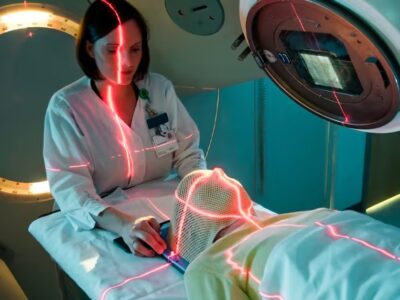
X-rays (radiography and CT), radiofrequency and magnetism (MRI) and ultrasound (ultrasound) make it possible to make images of the human body and to explore it. The technicians in medical radiology use many techniques, methods and equipment ranges from technologies in medical imaging: X-rays, ultrasound (ultrasound) and resonance imaging. magnetic.
The diversity of diagnostic examinations and the development of interventional radiology have contributed in recent years to expanding their field of activity and their responsibilities. Radioisotopes and radioactive substances administered to the patient in infinitesimal quantities that make it possible to know how an organ works.
In nuclear medicine, technicians in medical radiology use radioactivity. These are radioisotopes administered to the patient in infinitesimal quantities. Their preparations require specific skills in radiation protection and in radio chemistry (laboratory manipulation).
Nuclear medicine examinations produce and enable the creation of data that objectively reveals the structure and function of an organ (physiology). The emergence of hybrid techniques from the fields of radio diagnostics and nuclear medicine enhances the versatility.
Radiation oncology treats cancerous diseases with ionizing radiation: X-rays, gamma rays or electrons. With radiation oncology, medical radiology technicians treat cancers with the help of ionizing radiation. This field is primarily part of a multidisciplinary discipline.
In collaboration with the physician and the radio physicist, the medical radiology technician participates in the development and implementation of therapeutic plans. The technician in medical radiology participates in the development and implementation of therapeutic plans.

The technician in medical radiology plays an important role, insofar as they must guarantee the maintenance and the continuity of the care in the accompaniment and the follow-up of the patients. The profession is undergoing significant changes as a result of changes in technology, health policy, medicine and practice, as well as the expectations and needs of the population.
In this evolving context, the medical radiology technician must be able to ensure the quality of patient care in complex clinical situations and coordinate his activity within his profession in flexible work organizations. Interdisciplinary collaboration ensures continuity of patient care. Pilot technological chains of equipment in medical imaging and the realization of examinations.
Enhance the role of expert in radio protection and reduce X Ray Costs
on a daily basis for the safety of the patients and the people present in front of the radiological risks during the examinations with diagnostic and therapeutic aims. It ensures the collection, measurement and analysis of data. Participate critically in image acquisition protocols, analysis of images and therapeutic gestures (clinical reasoning).
Experts work in a versatile manner due to the emergence of hybrid technologies from radio diagnostics and nuclear medicine.











